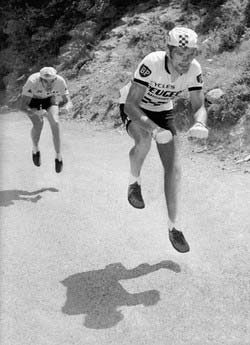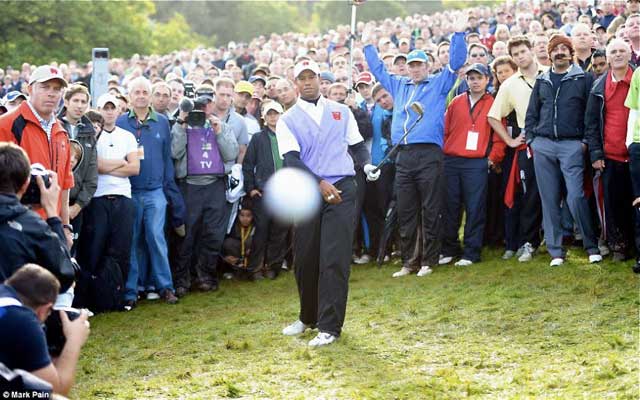sport

The idea of the ‘hot hand’, where a player who makes several successful shots has a higher chance of making some more, is popular with sports fans and team coaches, but has long been considered a classic example of a cognitive fallacy – an illusion of a ‘streak’ caused by our misinterpretation of naturally varying scoring patterns.
But a new study has hard data to show the hot hand really exists and may turn one of the most widely cited ‘cognitive illusions’ on its head.
{ Mind Hacks | Continue reading }
related { Why do some athletes choke under pressure? }
psychology, sport | October 24th, 2011 7:16 am

The human cannonball is a performance in which a person (the “cannonball”) is ejected from a specially designed cannon. The impetus is provided not by gunpowder, but by either a spring or jet of compressed air. In a circus performance, gunpowder may be used to provide visual and auditory effects, but this is unrelated to the launching mechanism.
The first human cannonball, in 1877 at the Royal Aquarium in London, was a 14 year-old girl called Zazel.
Historian A.H. Coxe says of 50 human cannonballs more than 30 have been killed, mostly by falling outside the net.
{ Wikipedia | The Straight Dope }
photo { Tereza Vlčková }
leisure, sport | September 1st, 2011 5:03 pm
sport | August 25th, 2011 4:44 pm
jeff koons, sport, visual design | August 1st, 2011 4:42 pm

craigslist > des moines
Jogging Partner
Date: 2011-05-26, 9:09PM
I am looking for a person of athletic build to help me get in shape.
I hate exercising with passion so the plan of action is this: I ingest Rohypnol [you supply the roofies as I don’t know where to purchase them] and you strap my body to yours [limbs to limbs using velcro] and take me along on a jog. Three nights a week. If you’re capable and interested, E-mail me so that we can discuss the fee.
Location: Des Moines, IA
{ Craigslist | Continue reading }
photo { Jacques-Henri Lartigue }
haha, sport | July 25th, 2011 9:09 am

On the plains of New Mexico, a band of elite marathoners tests a controversial theory of evolution: that humans can outrun the fastest animals on earth.
Between two and three million years ago, when our australopithecine ancestors ventured out of the forests and onto the protein-rich African savanna, they were prey more often than hunter. They gathered plant-based foods, just as their primate brethren did. Then something changed. They began running after game with long, steady strides. Evolutionary biologists like Harvard’s Dan Lieberman think the uniquely human capacity for endurance running is a distant remnant of prehistoric persistence hunting.
We can run all day, the theory goes, because there was once a caloric advantage to it. Our two human legs, packed as they are with long slow-twitch muscle fibers, make us better runners over long distances than most quadrupeds. And our three million sweat glands give us the ability to cool our bodies with perspiration. An antelope, by contrast, sprints—for up to 15 minutes—while wearing a fur coat and relies on respiration (panting) to release the heat that builds up with exertion. Add to the mix our ability to organize and strategize and, well, you can see how persistence hunting might actually work. (…)
There’s no hard archaeological evidence of persistence hunting, but half a dozen tribes are known to have pursued game this way in the past century: the Aborigines in Australia, the Navajo in the American Southwest, the Seri and Tarahumara Indians in Mexico. Of the tribes thought to practice it, though, only the Bushmen of the Kalahari Desert have been seen chasing antelope in recent decades. In the 1980s, South African mathematician Louis Liebenberg joined a successful Bushman persistence hunt for kudu in 107-degree heat.
{ Outside | Continue reading }
related { Does sexual intercourse hinder subsequent athletic performance? }
science, sport | May 24th, 2011 3:20 pm

Let’s consider the butterfly. One of the most taxing movements in sports, the butterfly requires greater energy than bicycling at 14 miles per hour, running a 10-minute mile, playing competitive basketball or carrying furniture upstairs. It burns more calories, demands larger doses of oxygen and elicits more fatigue than those other activities, meaning that over time it should increase a swimmer’s endurance and contribute to weight control.
So is the butterfly the best single exercise that there is? Well, no. The butterfly “would probably get my vote for the worst” exercise, said Greg Whyte, a professor of sport and exercise science. (…)
Ask a dozen physiologists which exercise is best, and you’ll get a dozen wildly divergent replies. (…)
Sticking with an exercise is key, even if you don’t spend a lot of time working out. The majority of the mortality-related benefits from exercising are due to the first 30 minutes of exercise. A recent meta-analysis of studies about exercise and mortality showed that, in general, a sedentary person’s risk of dying prematurely from any cause plummeted by nearly 20 percent if he or she began brisk walking (or the equivalent) for 30 minutes five times a week. If he or she tripled that amount, for instance, to 90 minutes of exercise four or five times a week, his or her risk of premature death dropped by only another 4 percent. So the one indisputable aspect of the single best exercise is that it be sustainable. From there, though, the debate grows heated.
{ NY Times | Continue reading }
photo { Indlekofer and Knoepfel }
guide, health, sport | April 29th, 2011 4:25 pm
sport, visual design | April 6th, 2011 5:39 pm
haha, sport | November 29th, 2010 6:39 pm
sport | October 5th, 2010 9:00 am

Grunting During a Tennis Shot May Provide a Competitive Advantage
Some tennis fans and players feel that grunting during a tennis shot distracts the opponent, and therefore provides an unfair competitive advantage. Many professional tennis players grunt; one of them (Maria Sharapova) is reported to grunt at over 100 decibels. (…)
Grunting slowed down student response time by between 21 and 33 milliseconds, and the students made between 3% and 4% more predicted directional errors, whether the video clips ended at contact with the ball or 100 milliseconds afterwards. These differences in time and error were statistically significant.
{ NASW | Continue reading }
psychology, sport | October 3rd, 2010 11:37 am

I’m not going to gripe about the price of tickets or the price of concessions or the exclusive Heineken sponsorship that forced me to drink, well Heineken, or even the weather, as you had no control over that.
But a few questions:
1. Upon arriving at the stadium bag-free as per your security notes, I was told that e-readers were not allowed in the stadium. E-READERS! iPhones, BlackBerries, video cameras, real cameras, these things are all allowed. On these things one can take pictures, video, talk, blog, surf the web. On an e-reader, one can … read. Why does the USTA hate literacy? By the way, I went to another entrance and snuck mine in, so take THAT!
{ Ken Wheaton | Continue reading }
experience, new york, sport | September 21st, 2010 2:32 pm

“Yoga is a good thing, so you tend to push further than you would in a sport where you are actually more attuned to injury and afraid of injuries,” said Dr. Michelle Carlson, an orthopedic surgeon at the Hospital for Special Surgery in Manhattan who specializes in arms and hands. She said she recently “saw four women in a row in my office with hand injuries from yoga.”
Nobody seems to keep careful track of the numbers. The most recent estimate comes from the United States Product Safety Commission, which tracks sports injuries: it listed 4,450 reported yoga injuries in 2006, up from 3,760 in 2004. But Dr. Carlson and several others said they had seen large increases lately, as yoga became more popular. “I have been doing this for 20 years, and I didn’t see yoga injuries 20 years ago,” Dr. Carlson said. “I can see a couple of injuries a week.”
Training for yoga teachers can vary, and classes are so large in some studios that instructors do not pay enough attention to everybody. In New York, many people approach yoga with a no-pain, no-gain mind-set, with predictable results.
Then there is the age factor: you see a fair share of middle-aged people twisting and bending and lunging, and I know from experience that a 40-something body is temperamental.
Back injuries are quite common. Positions like upward dog and cobra, requiring backbends, can aggravate the spine. Others that call for elongating the back, like seated forward bend, can wreak havoc on discs. Rotator cuffs and wrists can get battered during plank poses and chaturangas, which are like push-ups, while knees are susceptible to the lotus position, hero’s pose and the warrior positions.
The headstand — a more advanced move — is an equal opportunity offender. If done improperly, it can roil your back, neck, shoulders and wrists.
Then there are the freak injuries. A woman in crow pose fell over and broke her nose.
{ NY Times | Continue reading }
photo { Anthony Suau }
guide, health, new york, sport | July 25th, 2010 10:12 am

I am a nerd. This fact was quite apparent to many of those around me growing up, but came as quite a surprise to me. Part of the reason that I was regarded as a nerd was because I wasn’t into sports. (…) Being a nerd, of course, I developed my love through study, through reading. (…)
Through reading, sports ceased to be a private vocabulary—one that every other boy seemed to have had whispered into his ear at infancy, but which had strangely been denied to me—and became instead a new intellectual problem, something else to be considered and solved.
The thrill of sports is and will always be largely visceral. I would have it no other way. But behind the moments of raw action are endless intricacies, seemingly limitless geometries of movement which can be studied and enjoyed in precisely the same way one enjoys science, math or history. I’m sure some people are probably reading that sentence in horror–the division between jock and nerd is so elementary and animalistic I’m surprised Joseph Campbell never wrote about it–but I mean merely that intellectual play in the consideration of sports is little different than in any other subject. There is something universal in the basic pleasure of applying mind to (subject) matter and slowly, gradually, feeling the unknown become the familiar.
{ Freddie deBoer/Wunderkammer | Continue reading }
experience, ideas, mathematics, sport | May 25th, 2010 7:29 am

Competitors playing a match against Bobby Fischer, perhaps the greatest chess player of all time, often came down with a mysterious affliction known as “Fischer-fear.” Even fellow grandmasters were vulnerable to the effect, which could manifest itself as flu-like symptoms, migraines and spiking blood pressure. As Boris Spassky, Mr. Fischer’s greatest rival, once said: “When you play Bobby, it is not a question of whether you win or lose. It is a question of whether you survive.”
Recent research on what is known as the superstar effect demonstrates that such mental collapses aren’t limited to chess. While challenging competitions are supposed to bring out our best, these studies demonstrate that when people are forced to compete against a peer who seems far superior, they often don’t rise to the challenge. Instead, they give up. (…)
Because his competitors expect him to win, they end up losing; success becomes a self-fulfilling prophecy. (…)
In the early 1960s, the psychologist Sam Glucksberg demonstrated that the same effect could also inhibit creativity. He gave subjects a standard test of creativity known as the Duncker candle problem. The “high drive” group was told that the person solving the task in the shortest amount of time would receive $20. The “low drive” group, in contrast, was reassured that their speed didn’t matter. Here’s where the results get weird: The subjects with an incentive to think quickly took, on average, more than three minutes longer to find the answer. Experiments like this have led Ms. Beilock to conclude that people should be skeptical of evaluations based on a single high-stakes performance.
{ Wall Street Journal | Continue reading }
chess, psychology, sport | May 10th, 2010 9:03 am
psychology, sport | March 11th, 2010 4:46 pm

How to rate the sportsmen and women of the day against the stars of yesteryear.
There’s no easy way to make meaningful comparisons when sports change so dramatically over the years. Even in endeavours like baseball where player stats have been meticulously kept for almost a hundred years, comparisons across the decades can be odious. Is it really fair to compare players from the 1920s against those of the last 20 years when so many external factors have changed such as the use of new equipment, better training methods and, of course, performance enhancing drugs?
In 1914, the National League Most Valuable Player was Johnny Evers with a batting average of 0.279, 1 Home Run and 40 Runs Batted In. That was impressive then but these stats would embarrass even a second rate player in today’s game.
But what if there were a way to remove the systematic differences to reveal intrinsic talent? Today, Alexander Petersen at Boston University and a few pals explain just such a method that “detrends” the data leaving an objective measure of a player’s raw ability.
{ The Physics arXiv Blog | Continue reading }
flashback, science, sport | March 11th, 2010 4:42 pm

How far can bullets travel when fired into water?
The first candidate for this test was the Civil War rifle. At a range of 15 feet, the ballistics gel was completely unharmed; likewise at five feet. Only when the range was reduced to three feet did the bullet finally penetrate the gel, suggesting that diving under water was probably a pretty effective way of dodging slugs during the Civil War.
The experimenters moved on to the hunting rifle, which was loaded with a full-metal jacket .223 round that emerged at roughly 2,500 feet per second. At ten feet, the bullet disintegrated and the gel was untouched. At three feet, the bullet again broke up, with its tip coming to rest on the gel — not nearly enough power to damage flesh.
A bullet from the M1 Garand, with a muzzle speed of 2,800 ft/sec, also disintegrated at the ten-foot range. At two feet, the slug penetrated about four inches into the gel, suggesting a non-fatal wound. The armor-piercing .50 caliber round didn’t do any better — it, too, came apart at distances greater than five feet and lost most of its punch by three feet.
The engineers at the Central Scientific Research Institute for Precision Machinery Construction in Moscow correctly perceived the problem with shooting into water and in response developed the SPP-1 (Spetsialnyj Podvodnyj Pistolet, or “Special Underwater Pistol”) for use by Russian Navy frogmen. The SPP-1 is a manually operated four-barrel handgun that breaks open along the top and loads in a fashion similar to a double-barrel or over-and-under shotgun. The ammunition is designed to work underwater, using long bottlenecked rimmed casings plus bullets made from mild rather than hardened steel and designed to be stable underwater. The barrel isn’t rifled. According to the specs for the pistol, when fired at a depth of five meters — over sixteen feet — it’s lethal up to seventeen meters, or over fifty-five feet.
The SPP-1 isn’t the only exemplar of the breed. Other firearms are designed to work underwater as well, but they tend more towards the spear-gun model using dart-like projectiles. There’s no bright-line boundary where a bullet becomes a dart, but the projectiles fired by the Heckler & Koch P11 Underwater Pistol, for example, clearly cross the line. The H&K is an all-polymer weapon made especially for underwater use by the German Bundeswehr Kampfschwimmer — “army combat divers.” Each of the five dart-shaped projectiles is powered by a small, solid-fuel rocket. The weapon has been featured in some high-profile films, including Tomb Raider with Angelina Jolie, and is said to be able to inflict a fatal wound at fifty feet underwater.
{ The Straight Dope | NB: The article isn’t on the site anymore | Related: Can a bullet fired into the air kill someone when it comes down? }
photos/enlarge { 1. Howard Schatz | 2. Unsourced }
guns, photogs, sport, visual design | February 18th, 2010 5:00 pm
sport, video | November 13th, 2009 9:25 am



















